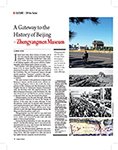A Gateway into History |
 |
<<Click to see original |
I must have been there dozens of times; yet it wasn’t until that long ago that I discovered that Zhengyangmen (正阳门), which means "gate of the zenith Sun", has a museum inside showing a fascinating perspective of old Beijing, together with very many photographs, some dating back a century or more.
Not familiar with Zhengyangmen? Maybe you know it by its more familiar name of Qianmen, which is the gate south of the Forbidden City and Tiananmen Square, though strictly speaking, ‘Qianmen’ consists of the gate – Zhengyangmen – together with its Arrow Tower – Jian Lou.
The main gateway of the gatehouse is aligned on Beijing’s major north-south axis, which includes Yongdingmen Gate to the south, the Mausoleum of Mao Zedong and the Monument to the People's Heroes in Tiananmen Square, Tiananmen Gate, the Meridian Gate, the imperial throne in the Hall of Supreme Harmony in the Forbidden City, the city's Drum and Bell Towers and the entrance to the Olympic Green out near the fourth ring road.
Zhengyangmen was the gate through which the emperor passed whenever he went to Tiantan (the Altar of Heaven), in the outer city, to make offerings. In fact the gateway would only be opened when emperors were passing through to give offerings or to carry out imperial inspections. Funeral vehicles were never allowed to pass Zhengyangmen during the Ming and Qing dynasties.
The other eight gates of the inner city were:
Deshengmen – literally " Gate of Virtuous Triumph" – and is homophonous with "achieving victory"; so troops would go through this gate on the way to an expedition.
Andingmen – "Peace and pacification" – was the gate armies would take when returning from the battlefield when the war was over and the country was peaceful. Beijing's main manure storage fields were located near the Temple of Earth, so most dung carts also accessed this gate.
Dongzhimen – also called 'Wood Gate', because bricks and wood needed by people inside the city were mainly brought through this gate.
Chaoyangmen, also known as grain gate, was the main route taken for transporting grain.
Chongwenmen – also known as Tax Gate – was where a customs station had been set up.
Xuanwumen – also called Prisoner Gate – was the only gate through which condemned criminals were sent for execution in the Qing dynasty.
Fuchengmen was used for transporting coal into the city
Xizhimen was used for transporting water to the imperial palace in both the Ming and Qing dyansties.
Zhengyangmen was first built in 1419 and once consisted of the gatehouse proper and an archery tower, which were connected by side walls with side gates, to form a large barbican.
During the Boxer Rebellion of 1900, the gate sustained considerable damage but it was extensively reconstructed in 1914, only to have the Barbican’s side gates torn down the next year.
In 1949, the Zhengyangmen gatehouse was occupied by the Beijing garrison of the People's Liberation Army, who only vacated it in 1980; but now it has rightly become a big tourist attraction.
Unfortunately, “progress” waits for no man, and Zhengyangmen was one of only a handful of gates that survived the demolition of city walls in the late 1960s and ’70s during the building of the Beijing Subway. (Line 2's Qianmen Station is actually located between the two structures inside the space once surrounded by the barbican.)
The museum itself covers the history of old Beijing, and contains many notable items in its collection. For instance, there is a super-long painting of Emperor Qianlong's first tour to Jiangsu and Zhejiang in 1751. It was drawn by court painter Xu Yang and consists of a number of scrolls each measuring 868.6cm x 1988.6cm. Or rather, the original is in the China National Museum, and this is a copy. But it’s still lovely despite that, and few visitors are any the wiser!

The detail is exquisite and clearly shows the entire barbican with the two towers to north and south.
And if you love old photographs, then you will be taken with shots of what this area was like before the rebuilding started in 1914.
In order to alleviate traffic congestion, the Moon Fortress enclosure was demolished in 1915 and two side gateways were opened in the walls flanking the Gatehouse tower. Roads were paved; a zigzag ascending path was built for the Archery Tower and decorated in the Western style. So this was what it looked like just after the rebuilding in 1915.
Other famous moments in history were captured at the tower, such as on May 27, 1929, when Sun Yat-sen's coffin passed through the Gatehouse when it was conveyed to Nanjing for interment.
On July 7, 1937 the Marco Polo Bridge incident broke out, marking the start of China entering the Second World War, known locally as the War of Resistance against Japanese Aggression. On July 28 Japanese forces captured Beiping (as it was then known) and entered the Inner City via Zhengyangmen on August 8th.
But on January 31, 1949, Beiping was peacefully liberated; and on February 3rd the PLA marched into the city through the gate in a grand ceremony.
Today Zhengyangmen still has an important role to play that not many Beijingers are even aware of. The kilometre zero point for highways in China (the point from which all distances are measured) is located just outside the gate and marked with a plaque in the ground. Zero Point was approved by the State Council and installed in September 2006. Four ancient Chinese mythical animals – a Qinglong (Green Dragon), Baihu (White Tiger), Zhuque (Vermilion bird) and Xuanwu (Black Tortoise) represent East, West, South and North. Meanwhile the wheel in the centre represents the system of highways radiating to all parts of China.
